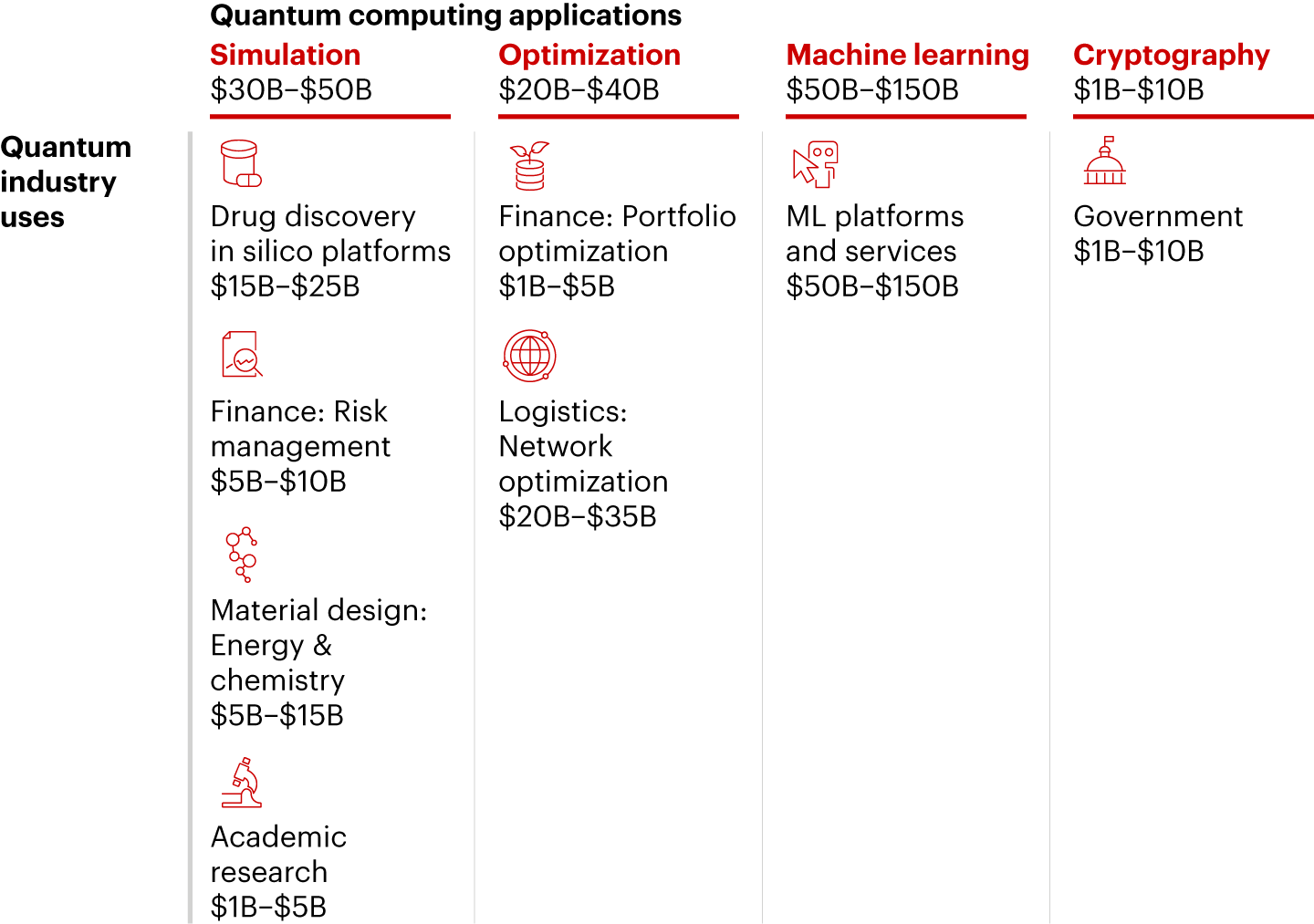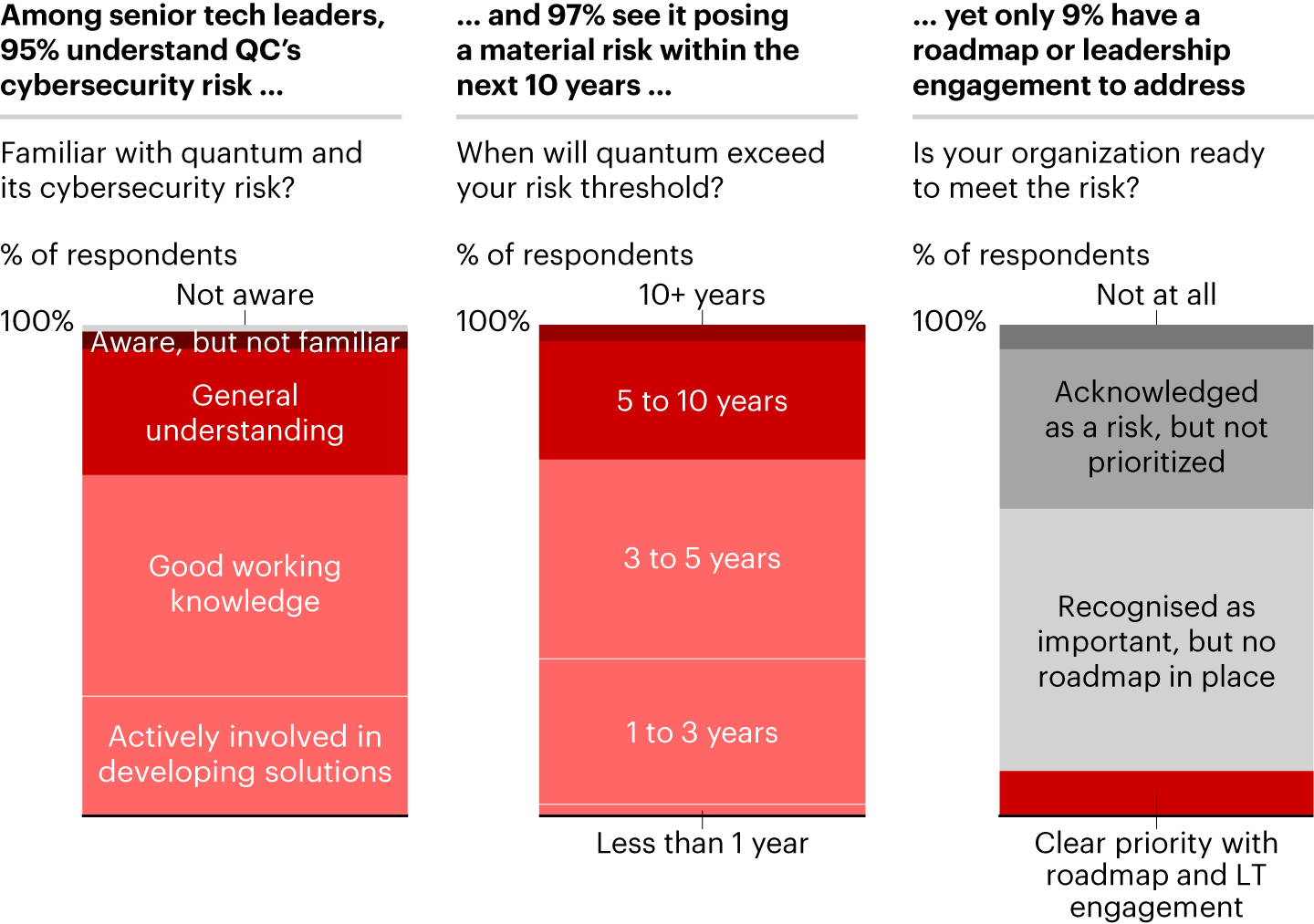This article is part of Bain’s Technology Report 2025
Over the past two years, quantum computing has moved closer to practical, real-world applications. Breakthroughs in fidelity, error correction, and scaling qubits (the basic units of quantum computing, like the 0’s and 1’s bits in classical computing) across platforms signal that it’s not a question of if but when.
Investment is following suit. Tech giants like Alphabet, IBM, and Microsoft are doubling down, while governments are scaling national quantum strategies. And it’s not just computing: Quantum sensing, communication, and annealing (a technique for solving optimization problems) are already at work.
Given the early state of commercialization, expansive and open-minded approaches are critical for the development of specific types of qubits; the infrastructure necessary to scale and manage quantum components that will run alongside the host classical systems; and algorithms and middleware tools for connecting with data sets and sharing results.
IBM has taken this broad view, developing several generations of quantum-related technologies over the past 20 to 30 years. The company has generated interest in its quantum computing systems among academic and industrial users, in some cases by supporting solution providers as they explore the market.
But the field remains open. No single technology or vendor has pulled ahead, and many technical hurdles remain. Experimentation costs have fallen, and companies can now embark on exploring quantum with relatively modest entry costs. The opportunities and uncertainties make preparation and agility key.
Quantum’s big market potential: Big but uncertain
Quantum could unlock as much as $250 billion of market value across industries like pharmaceuticals, finance, logistics, and materials science (see Figure 1). While the full potential is immense, the pace of progress and extent of realization are uncertain, and many advances will need to be made beyond qubit scaling. To reach full market potential, a fully capable, fault tolerant computer at scale will be needed—and that’s still years away.
Quantum computing’s market potential could be between $100 billion and $250 billion


Source: Bain analysis
At least four major barriers stand in the way:
Hardware maturity: Quantum computing faces steep technological hurdles before it can reach full potential, many having to do with the need to convert or hold information in the fragile quantum state. These include physical scaling, fidelity and error correction, coherence times (that is, how long a qubit can retain its quantum state), quantum memory (similarly, the ability to store quantum information reliably over time), data loading (the process of converting traditional data to quantum information), and qubit control bottlenecks (the ability to manipulate qubits without losing fidelity or picking up cross-talk). Although some might hope for a Moore’s law relative to qubit scaling, the nature of quantum devices and the challenges of scaling here are quite different, and their difficulty increases exponentially with qubit count.
Algorithm maturity: While quantum computing hardware garners most of the headlines, for many use cases, practical application will require major advances in quantum algorithms (QA). Research is ongoing and major progress has been made in optimizing existing quantum algorithms, but the pace of new QA development has slowed.
Quantum machine learning (QML): Over half the projected market value (about $150 billion) sits here, but it’s still mostly theoretical. Key algorithmic and data-loading bottlenecks suggest this could be among the later use cases realized, and the applications for the highest-value machine-learning cases (generative AI, LLMs) remain even more speculative.
Practical ROI: Many current quantum targets, including simulation and optimization, are already being tackled with “good enough” classical computing. To justify using quantum computing instead, it would need to deliver real, sustained performance and cost advantages in places where classical computing approaches fall short, even as classical computing continues to advance.
Some expect a single “quantum breakthrough,” but we anticipate more of a gradual curve: early wins in narrow domains within five to ten years with broader adoption unfolding over time.
The market today for quantum computing hardware and services is less than $1 billion a year. Barring a major breakthrough, roadmaps suggest that over the next five to ten years we’ll see initial examples of quantum supremacy—quantum computers outperforming classical approaches in practical and useful applications—although the scope of application will be limited. These earliest practical applications in simulation (for example, metallodrug- and metalloprotein-binding affinity, battery and solar material research, or credit derivative pricing) and optimization (logistics, portfolio analysis) will boost the quantum computing market to between $5 billion and $15 billion by 2035—still a far cry from the $250 billion a fully capable, full-potential quantum computing could unlock.
Getting ahead means choosing the right pilot use cases and investing in talent and technical readiness now.
Cybersecurity: Quantum’s immediate implication
The potential for quantum computing to overcome today’s best encryption is real. Although today’s quantum computing can’t break state-of-the-art encryption yet, some malicious organizations have embarked on a strategy of “harvest now, decrypt later,” intending to store sensitive data for five years or more, until the evolution of quantum empowers them to break the encryption.
Bain’s recent survey on the implications of post-quantum cryptography (PQC) on cybersecurity found that 73% of IT security professionals expect this to be a material risk within five years, and 32% expect it within three years, though some expect it will take longer (see Figure 2). However, even if it takes years for quantum to crack today’s levels of encryption, PQC is becoming a necessity. Still, only 9% of tech leaders surveyed said they have a roadmap in place for dealing with it.
Most tech leaders recognize quantum’s cybersecurity risk, but very few have a plan to address it


Note: The survey population varies by question because respondents were screened out based on certain criteria, ranging from 182 to 226 participants
Source: Bain Post Quantum Cryptography (PQC) Survey, May 2025
The transition isn’t easy; it requires mapping the company’s cryptographic landscape, updating protocols, and ensuring compliance. Companies will need to update their IT and cyber technology stacks with PQC-enabled solutions. For large or legacy-heavy organizations, this process could take years.
A future of hybrid solutions
Quantum computing will not replace classical computing—it will complement it, becoming an important part of a broad mosaic of solutions. Quantum computing will play a targeted role, solving specific problems where classical systems fall short. Quantum computing is likely to replace supercomputing tasks in initial applications, where it won’t compete with high-performance data centers. As it evolves, it’s likely to take on a wider range of activity, but still in a hybrid fashion where it will work with classical computing to form complete solutions. Already, much of the focus is on developing architectures in which quantum and classical computing work well together.
The future compute stack will be a mosaic, with quantum processors alongside CPUs, GPUs, and other accelerators optimized for specific functions. Winning companies will be those who can knit these together into a unified, high-performing system.
Symmetrically, the future of analytics will be a mosaic, too: with capabilities ranging from simple regressions to AI, agentic, high-performance compute capabilities and quantum algorithms, each evolving in complementary fashion and directed at specific business problems.
Mobilize today; lead tomorrow
For many companies, the most pressing need is securing data for a post-quantum world. In sectors where quantum is likely to have a near-term impact, developing readiness is more operational than technical. That means defining target use cases, building capabilities, forming partnerships, and scanning for signals in a fast-moving space.
Working with companies to assess their quantum readiness, we’ve seen it takes three to four years on average to go from awareness to a structured approach that includes a strategic roadmap, an ecosystem of partnerships, and pilot programs. Moving quantum use cases from R&D out to business units and functions, including the time needed to experiment and climb learning curves, can take between six and nine months. This reflects the time needed for mathematical modeling, algorithm tuning, formatting incoming and outgoing data, deployment, interpretation, impact on competitiveness, as well as recruiting and training the right people. The challenge today is navigating between moving too quickly (including overinvesting) in a not-yet-mature technology and moving too slowly, which could leave a company struggling to keep pace with competitors.
Most companies are still in the early stages. With talent scarce and the learning curve steep, those who move now will shape the quantum landscape later.
More from the report
Read our Technology Report 2025

